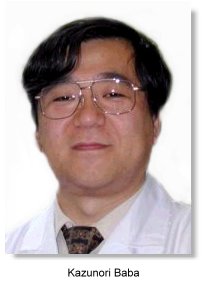
Baba first reported on a 3D ultrasound system in 1984 and succeeded in obtaining 3D ultrasound fetal images by using a mini-computer in 1986. This was reported in the Acta Obstetrica et Gynaecologica Japonica. He also applied this system to placental blood flow and breast disorders in 1990 to 1991. Baba wrote a comprehensive book on diagnostic ultrasound in obstetrics and gynecology including 3D ultrasound in 1992 and edited "Three-dimensional ultrasound in obstetrics and gynecology" (Parthenon Publishing), the first book devoted entirely to 3D ultrasound, in collaboration with Davor Jurkovic in London in 1996. In the mid 1990s, Baba collaboration with ALOKA?on technology developed at the Biomedical Engineering Department of the Tokyo University and was a driving force in the development of commercial 3-D ultrasound equipments in Japan, and indeed worldwide. In November 1996, with technical assistance from Takashi Okai and Shiro Kozuma from ALOKA®, Baba published in the Lancet initial experience with real-time processible 3-D, which was a procedure simpler than conventional 3D ultrasound rendering basing on the method of 'accoustic impedance thresholding' to identify fetal surfaces in the amniotic fluid. Image quality was very high and required less expensive computers to make the calculations. Baba was invited to speak at the first World Congress on 3D Ultrasound in Obstetrics and Gynecology in Mainz in 1997 and the second congress in Las Vegas in 1999.
Baba was also heavily involved with teaching of ultrasonography. He was active in promoting conventional 2D ultrasound and Doppler ultrasound in obstetrics and gynecology. He gave many educational lectures and made 11 videos and wrote many articles in book chapters and magazines. In 1993 he published: A manual of diagnostic ultrasound in obstetrics and gynecology which was a 7-parts video series.
He also developed a control system for an artificial uterus and succeeded in incubating a goat fetus in the artificial uterus for 3 weeks and is also involved in the development of an artificial heart.
Dr. Baba is a member of the editorial board of "Ultrasound in Obstetrics and Gynecology" and "The Ultrasound Review of Obstetrics and Gynecology".

Some of Dr. Baba's important Publications:
Baba K, et al: Development of a system for ultrasonic fetal
three-dimensional reconstruction. Acta Obstetrica et Gynaecologica
Japonica, 38(8), 1385, 1986.
Baba K, et al: Non-invasive three-dimensional imaging system for the
fetus in utero. In Maeda K ed. The Fetus as a Patient '87, Excerpta
Medica (Amsterdam), 111-116, 1987.
Kuwabara Y, et al: Development of an extrauterine fetal incubation
system using extracorporeal membrane oxygenator. Artificial Organs,
11(3), 224-227, 1987.
Baba K, et al: Development of an ultrasonic system for
three-dimensional reconstruction of the fetus. J. Perinat. Med. 17(1),
19-24, 1989.
Baba K, et al: Ultrasonic three-dimensional imaging system for the
fetus in utero. In Maeda K, Hogaki M and Nakano H ed. Computers and
Perinatal Medicine. Excerpta Medica (Amsterdam). 83-92, 1990.
Baba K: Diagnostic ultrasound in obstetrics and gynecology -from
transabdominal to transvaginal, from 2D to 3D- . Nanai Publishing
(Osaka), 1992.

Baba K et al: A manual of diagnostic ultrasound in obstetrics and
gynecology (7-parts video series). Medical View (Tokyo), 1993.
Baba K, et al: Real-time processable three-dimensional fetal
ultrasound. The Lancet, 348(9037), 1307, 1996.
Baba K and Jurkovic D. ed: Three-dimensional Ultrasound in Obstetrics
and Gynecology, Parthenon Publishing(Carnforth,UK), 1997.
Baba K, et al: Real time processable three-dimensional ultrasound in
obstetrics. Radiology, 203(2), 571-574, 1997.
Unno N et al: An evaluation of the system to control blood flow in
maintaining goat fetuses on arterio-venous extracorporeal membrane
oxygenation: a novel approach to the development of an artificial
placenta. Artificial Organs, 21(12), 1239-1246, 1997.
Baba K: Instrumentation in vaginosonography. In Allahbadia G ed.
Transvaginal Sonography in Infertility. Rotunda Medical Technologies
Pvt Ltd(Mumbai, India), 7-10, 1998.
Baba K: Development of three-dimensional ultrasound in obstetrics and
gynecology: Technical aspects and possibilities. In Merz E ed. 3-D
Ultrasound in Obstetrics and Gynecology. Lippincott Williams &Wilkins
(Philadelphia, USA), 3-8, 1998.
Abe Y, et al: Over 500 day's survival of a goat with a total
artificial heart with 1/R control. In Akutsu T and Koyanagi H ed.
Heart Replacement - Artificial Heart 6. Springer-Verlag (Tokyo),
34-38, 1998.
Baba K: Fetal abnormalities: evaluation with real-time-processible
three-dimensional US - preliminary report. Radiology, 211(2), 441-446,
1999.
Kozuma S, et al: Goat fetuses disconnected from the placenta, but
reconnected to an artificial placenta, display intermittent breathing
movements. Biol Neonate, 75(6), P388-397, 1999.
Baba K, et al: Where does the embryo implant after embryo transfer in
humans?. Fertil Steril, 73(1), 123-125, 2000.
Baba K and Takeuchi H ed: Three-dimensional ultrasound. Medical View
(Tokyo), 2001.